The Radiation Therapy Software Market is estimated to be valued at USD 449.6 million in 2025 and is projected to reach USD 988.7 million by 2035, registering a compound annual growth rate (CAGR) of 8.2% over the forecast period.
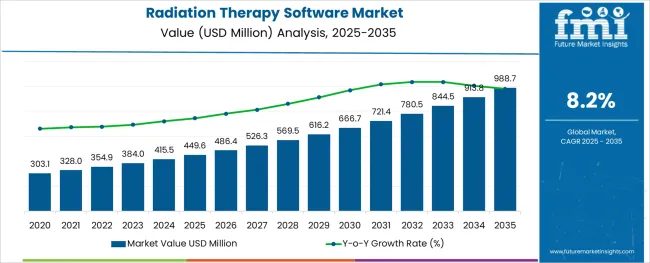
The radiation therapy software market is experiencing steady advancement as oncology care increasingly relies on precision-driven digital infrastructure to enhance treatment planning, imaging, and delivery. The shift from legacy systems to cloud-enabled platforms is being reinforced by demand for centralized data access, real-time collaboration, and high-speed computation capabilities essential in modern cancer care.
Hospital networks and specialized oncology centers are adopting next-generation software to streamline workflows, support multi-modality imaging integration, and comply with evolving clinical protocols. Emphasis on personalized treatment regimens and adaptive radiotherapy has accelerated innovation in dose optimization and AI-supported planning algorithms.
Vendor collaborations with healthcare providers and continuous updates for interoperability with linear accelerators and imaging tools are also shaping future deployment models. The growth trajectory is expected to benefit from rising cancer incidence, increased global radiotherapy infrastructure investment, and the drive toward value-based care models that demand more accurate and efficient treatment software ecosystems.
The market is segmented by Deployment and End User and region. By Deployment, the market is divided into Cloud Based Platform and On Premises. In terms of End User, the market is classified into Hospitals, Ambulatory Surgical Centres, Specialty Cancer Centres, Cancer Research Institutes, and Others. Regionally, the market is classified into North America, Latin America, Western Europe, Eastern Europe, Balkan & Baltic Countries, Russia & Belarus, Central Asia, East Asia, South Asia & Pacific, and the Middle East & Africa.
The market is segmented by Deployment and End User and region. By Deployment, the market is divided into Cloud Based Platform and On Premises. In terms of End User, the market is classified into Hospitals, Ambulatory Surgical Centres, Specialty Cancer Centres, Cancer Research Institutes, and Others. Regionally, the market is classified into North America, Latin America, Western Europe, Eastern Europe, Balkan & Baltic Countries, Russia & Belarus, Central Asia, East Asia, South Asia & Pacific, and the Middle East & Africa.
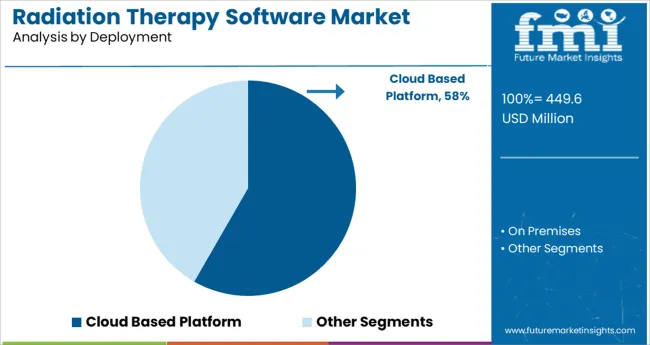
The cloud based platform segment is anticipated to command 58.3% of the total deployment revenue share in 2025, making it the leading model in the market. Its dominance is driven by the scalability, security, and interoperability benefits that cloud infrastructure offers in oncology software environments.
Cloud deployment allows for real-time data exchange between oncologists, radiologists, and medical physicists across locations, reducing treatment planning time and enhancing collaboration. Additionally, cloud-based systems support remote updates, cybersecurity enhancements, and simplified compliance with data protection regulations such as HIPAA and GDPR.
The ability to integrate with AI algorithms for auto-contouring, dose prediction, and adaptive planning is also contributing to its widespread acceptance. Cloud-based solutions have become the preferred option among healthcare providers aiming to future-proof their radiotherapy departments while reducing IT overheads and ensuring operational continuity across multi-site care settings.
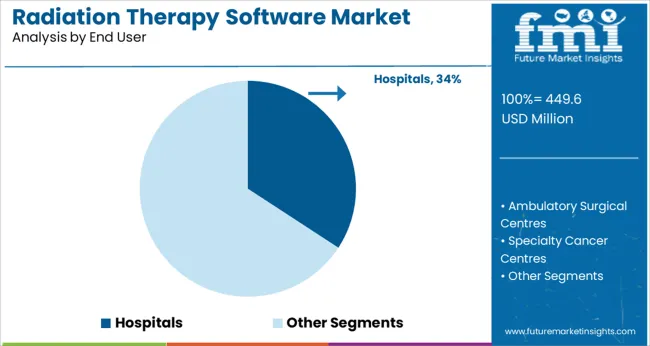
Hospitals are projected to hold 34.2% of total market revenue in 2025 within the end user category, positioning them as the leading adopters of radiation therapy software. This leadership is driven by their role as primary treatment providers for a significant proportion of cancer patients globally.
Hospitals require robust, scalable software solutions to manage high patient volumes, integrate with diagnostic imaging systems, and ensure accurate dose delivery across diverse radiotherapy equipment. Investment in state-of-the-art oncology departments, often supported by government initiatives or institutional funding, has led hospitals to upgrade from standalone planning systems to enterprise-wide platforms.
Software functionalities such as image-guided radiotherapy, motion management, and automated quality assurance are being integrated into hospital-based systems to meet growing clinical demands. The emphasis on precision medicine and multidisciplinary cancer care teams has reinforced the reliance on centralized software ecosystems in hospital environments, supporting the segment’s continued growth through 2025 and beyond.
GLOBOCAN 2024 says that in 2024, there were nearly 19.29 million new cancer cases across the world, and this figure is anticipated to reach 28.4 million by the end of 2040. Globally, the prevalence of cancer is projected to be 50.6 million.
This is a five-year prevalence, meaning the total number of individuals living with cancer in the past five years. The alarmingly increasing rate of cancer is resulting in the demand for radiation therapy software and eventually promoting the growth of the market.
Radiation therapy planning and delivery procedure enable smooth incorporation of computerized data sources, computer control systems, software tools, and computer control systems, therefore enabling natural workflow and clinicians to collect patients’ information from diseases diagnosis through treatment and follow-up to deliver the most efficient treatment plans and conduct quality assurance procedures safely and effectively.
The increasing need for effective and integrated workflow platforms to ensure efficient and precise informed clinical decision-making coupled with growing cases of cancer together are likely to propel the global radiation therapy software market during the forecast period.
Moreover, integrated radiation therapy software decreases transcription errors and unwanted patient wait times by removing the data entry errors. Frequent updates in the existing software are expected to lead to the growing market value of radiation therapy software during the forecast years.
Application Insights
In 2024, the radiation therapy software market's largest share was expected to go to patients with prostate cancer. One of the most cutting-edge ways to treat prostate cancer is with prostatic brachytherapy. Prostate cancer patients can benefit from LDR or HDR brachytherapy.
The treatment of high-risk prostate cancer with brachytherapy is becoming more common worldwide. It can be used on its own or in conjunction with other treatments like hormone therapy or external beam radiation therapy (EBRT). LDR brachytherapy is as effective as prostatectomy or EBRT because it delivers low doses of radiation and protects healthy tissues around the tumour.
In addition, because the radioactive seeds implanted in the prostate move with it, brachytherapy does not require any monitoring of the gland's movement.
Globally, the healthcare IT market is anticipated to boom in the future. The healthcare IT industry takes exception to numerous industries, this includes healthcare, medical technology, digital health, medical devices, and healthcare. This industry is said to disturb the conventional healthcare delivery model and research systems by using modern and enhanced technologies. This is expected to change the radiation therapy software market outlook.
End-User
Hospital is expected to account for the biggest market share of the global radiation therapy software market during the forecast period. The growing adoption of radiation therapy software at hospitals is owing to a greater number of information generated during treatment and diagnosis of cancer and a considerable number of patient visits/submissions each year across the world.
Growing government initiatives focusing on equipping hospitals with the latest and advanced systems are a few of the factors accountable for the growth of this segment.
Lack of skilled technicians and clinicians, and unexpected errors in the software program, namely bugs, can restrict the growth of the global radiation therapy software market. Underdeveloped economies having a lack healthcare infrastructure is likely to disrupt the growing market during the forecast period.
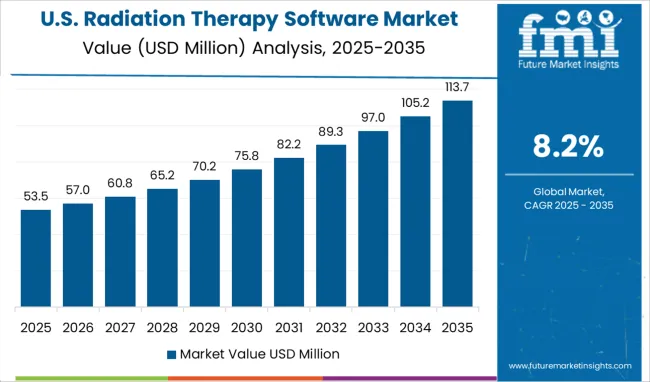
North America is accountable for 38% market share in the global radiation therapy software market. This region’s market is said to maintain its market position during the forecast period owing to increased and heavy dependency of clinicians on advanced disease platforms.
The region makes use of advanced services because there is a growing number of patients suffering from cancer every year. This has led to expanding radiation therapy software market value and therefore growing demand for radiation therapy software.
Accessibility to advanced healthcare infrastructure assists in maintaining a larger radiation therapy software market share in North America.

Europe radiation therapy software market to hold 31% share in the global market. This region is accountable for the second largest radiation therapy software market share after North America owing to increasing awareness pertaining to the treatment demands.
Accessibility to more accurate and efficient cancer treatments, increasing research and development activities, and partnerships among manufacturers are predicted to boost the radiation therapy software market in Europe.
In Europe, Germany is anticipated to progress at a higher CAGR during the forecast period. This is because healthcare providers are focusing more on radiotherapy patient positioning, as this technique assists patients with multiple radiations in lesser sessions, therefore saving on money and time.
The start-up ecosystem in the radiation therapy software market is heavily influenced by the latest developments in the industry.
In February 2020, Johnson & Johnson innovation led a USD 25 million Series A in Fusion Pharmaceuticals, which is a targeted cancer radiotherapeutic start-up. The funding is expected to support phase 1A of Fusion’s antibody-targeted radiotherapy, beyond which the company plans to run a proof-of-concept trial in non-small cell lung cancer.
In July 2025, RefleXion Medical took on a USD 125 Million loan ahead of the FDA decision on radiotherapy technology. The company is all-in on its biology-guided radiotherapy (BgRT) system. The start-up has more than doubled its existing debt to prepare for the technology’s commercial launch.
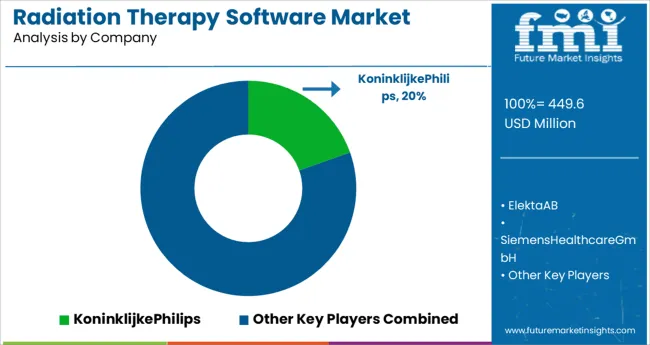
Some of the key players in the radiation therapy software market are Koninklijke Philips, N.V Elekta AB, Siemens Healthcare GmbH Brainlab AG, Standard Imaging Inc, RAYSEARCH LABORATORIES and Varian Medical Systems, Inc.
Market players have adopted strategies such as product approvals, product launches, market initiatives, and mergers and acquisitions. In June 2024, Royal Philips, and Elekta had an agreement to strengthen their existing strategic partnership to improve complete and customized cancer care through precision oncology solutions.
The broadened alliance develops on the two companies’ successful cooperation in the fast-developing field of magnetic resonance (MR) guided adaptive radiation therapy. Across deeper cross-portfolio collaboration, Philips and Elekta are forecasted to employ their corresponding capabilities to further improve patient care.
| Report Attribute | Details |
|---|---|
| Growth Rate | CAGR of 8.20% from 2025 to 2035 |
| Base Year for Estimation | 2024 |
| Historical Data | 2020 to 2024 |
| Forecast Period | 2025 to 2035 |
| Quantitative Units | Revenue in USD Million and CAGR from 2025 to 2035 |
| Report Coverage | Revenue Forecast, Volume Forecast, Company Ranking, Competitive Landscape, Growth Factors, Trends and Pricing Analysis |
| Segments Covered | Deployment, End User, Region |
| Regions Covered | North America, Latin America, Europe, East Asia, South Asia, Oceania, Middle East and Africa |
| Key Countries Profiled | USA, Canada, Brazil, Argentina, Germany, UK, France, Spain, Italy, Nordics, BENELUX, Australia &, New Zealand, China, India, ASEAN, GCC, South Africa |
| Key Companies Profiled | Koninklijke Philips, N.V Elekta AB, Siemens Healthcare GmbH, Brainlab AG, Standard Imaging Inc, RAYSEARCH LABORATORIES, Varian Medical Systems, Inc. |
| Customization | Available Upon Request |
The global radiation therapy software market is estimated to be valued at USD 449.6 million in 2025.
It is projected to reach USD 988.7 million by 2035.
The market is expected to grow at a 8.2% CAGR between 2025 and 2035.
The key product types are cloud based platform and on premises.
hospitals segment is expected to dominate with a 34.2% industry share in 2025.






Our Research Products

The "Full Research Suite" delivers actionable market intel, deep dives on markets or technologies, so clients act faster, cut risk, and unlock growth.

The Leaderboard benchmarks and ranks top vendors, classifying them as Established Leaders, Leading Challengers, or Disruptors & Challengers.

Locates where complements amplify value and substitutes erode it, forecasting net impact by horizon

We deliver granular, decision-grade intel: market sizing, 5-year forecasts, pricing, adoption, usage, revenue, and operational KPIs—plus competitor tracking, regulation, and value chains—across 60 countries broadly.

Spot the shifts before they hit your P&L. We track inflection points, adoption curves, pricing moves, and ecosystem plays to show where demand is heading, why it is changing, and what to do next across high-growth markets and disruptive tech

Real-time reads of user behavior. We track shifting priorities, perceptions of today’s and next-gen services, and provider experience, then pace how fast tech moves from trial to adoption, blending buyer, consumer, and channel inputs with social signals (#WhySwitch, #UX).

Partner with our analyst team to build a custom report designed around your business priorities. From analysing market trends to assessing competitors or crafting bespoke datasets, we tailor insights to your needs.
Supplier Intelligence
Discovery & Profiling
Capacity & Footprint
Performance & Risk
Compliance & Governance
Commercial Readiness
Who Supplies Whom
Scorecards & Shortlists
Playbooks & Docs
Category Intelligence
Definition & Scope
Demand & Use Cases
Cost Drivers
Market Structure
Supply Chain Map
Trade & Policy
Operating Norms
Deliverables
Buyer Intelligence
Account Basics
Spend & Scope
Procurement Model
Vendor Requirements
Terms & Policies
Entry Strategy
Pain Points & Triggers
Outputs
Pricing Analysis
Benchmarks
Trends
Should-Cost
Indexation
Landed Cost
Commercial Terms
Deliverables
Brand Analysis
Positioning & Value Prop
Share & Presence
Customer Evidence
Go-to-Market
Digital & Reputation
Compliance & Trust
KPIs & Gaps
Outputs
Full Research Suite comprises of:
Market outlook & trends analysis
Interviews & case studies
Strategic recommendations
Vendor profiles & capabilities analysis
5-year forecasts
8 regions and 60+ country-level data splits
Market segment data splits
12 months of continuous data updates
DELIVERED AS:
PDF EXCEL ONLINE
Radiation Tolerant LED Light Market Size and Share Forecast Outlook 2025 to 2035
Radiation Hardened Electronics Market Size and Share Forecast Outlook 2025 to 2035
Radiation Protection Cabins Market Size and Share Forecast Outlook 2025 to 2035
Radiation-Free Fetal Heart Rate Monitor Market Size and Share Forecast Outlook 2025 to 2035
Radiation Hardened Microcontrollers Market Size and Share Forecast Outlook 2025 to 2035
Radiation Detection Device Market Size and Share Forecast Outlook 2025 to 2035
Radiation Curable Coatings Market Size and Share Forecast Outlook 2025 to 2035
Radiation Toxicity Treatment Market Size and Share Forecast Outlook 2025 to 2035
Radiation-Induced Myelosuppression Treatment Market Size and Share Forecast Outlook 2025 to 2035
Radiation Tester Market Growth – Trends & Forecast 2025 to 2035
Radiation-Induced Fibrosis Treatment Market - Growth & Forecast 2025 to 2035
Radiation Proctitis Treatment Market
Radiation Dose Optimisation Software Market Size and Share Forecast Outlook 2025 to 2035
Irradiation Apparatus Market Trends – Growth & Industry Outlook 2024-2034
Food Irradiation Equipment Market Size and Share Forecast Outlook 2025 to 2035
Food Irradiation Market Analysis - Size, Share, and Forecast Outlook 2025 to 2035
Medical Radiation Detectors Market
Internal Radiation Therapy Market Trends – Growth & Forecast 2024-2034
Cutaneous Radiation Injury Treatment Market
Superficial Radiation Therapy System Market Size and Share Forecast Outlook 2025 to 2035

Thank you!
You will receive an email from our Business Development Manager. Please be sure to check your SPAM/JUNK folder too.
Chat With
MaRIA